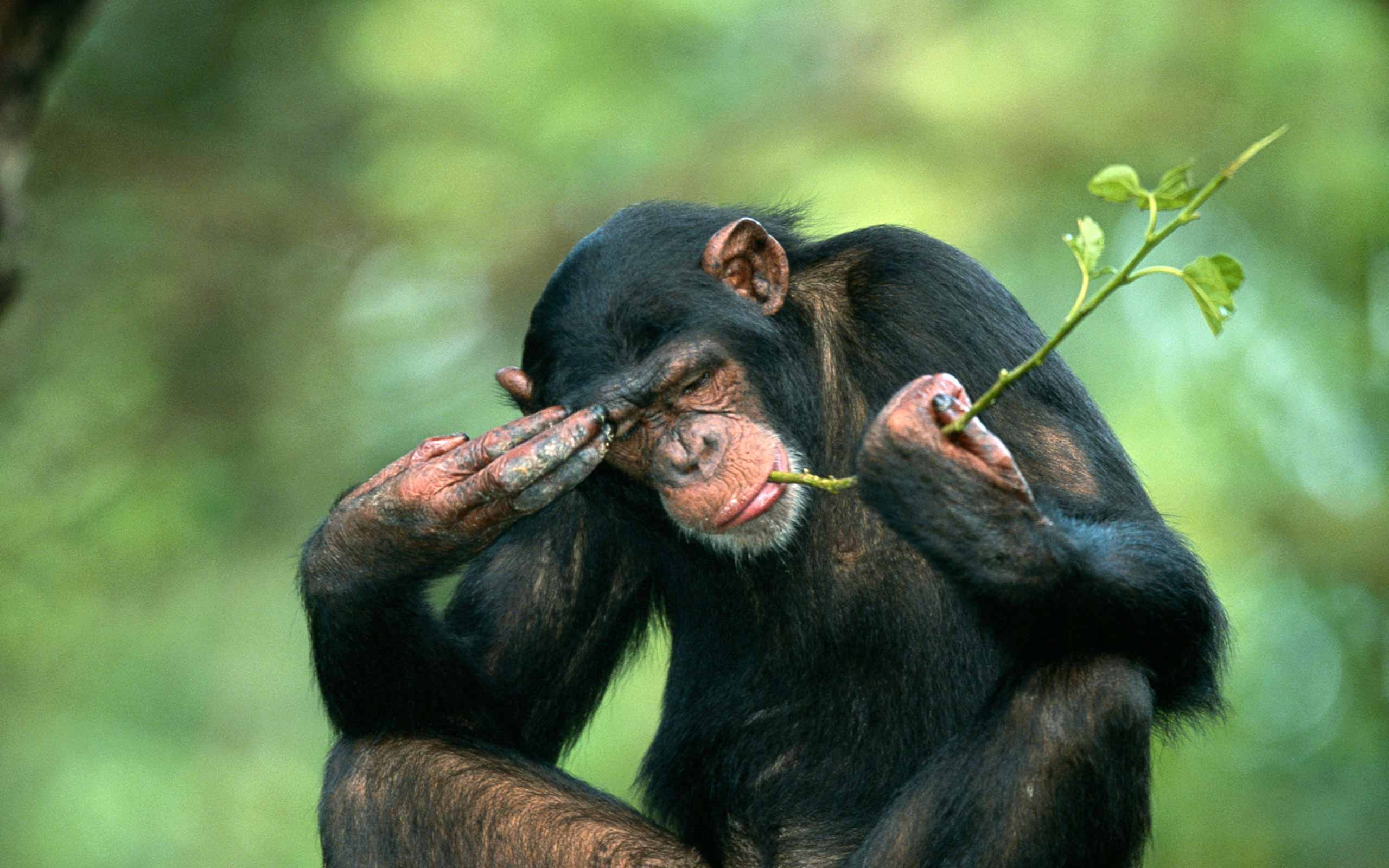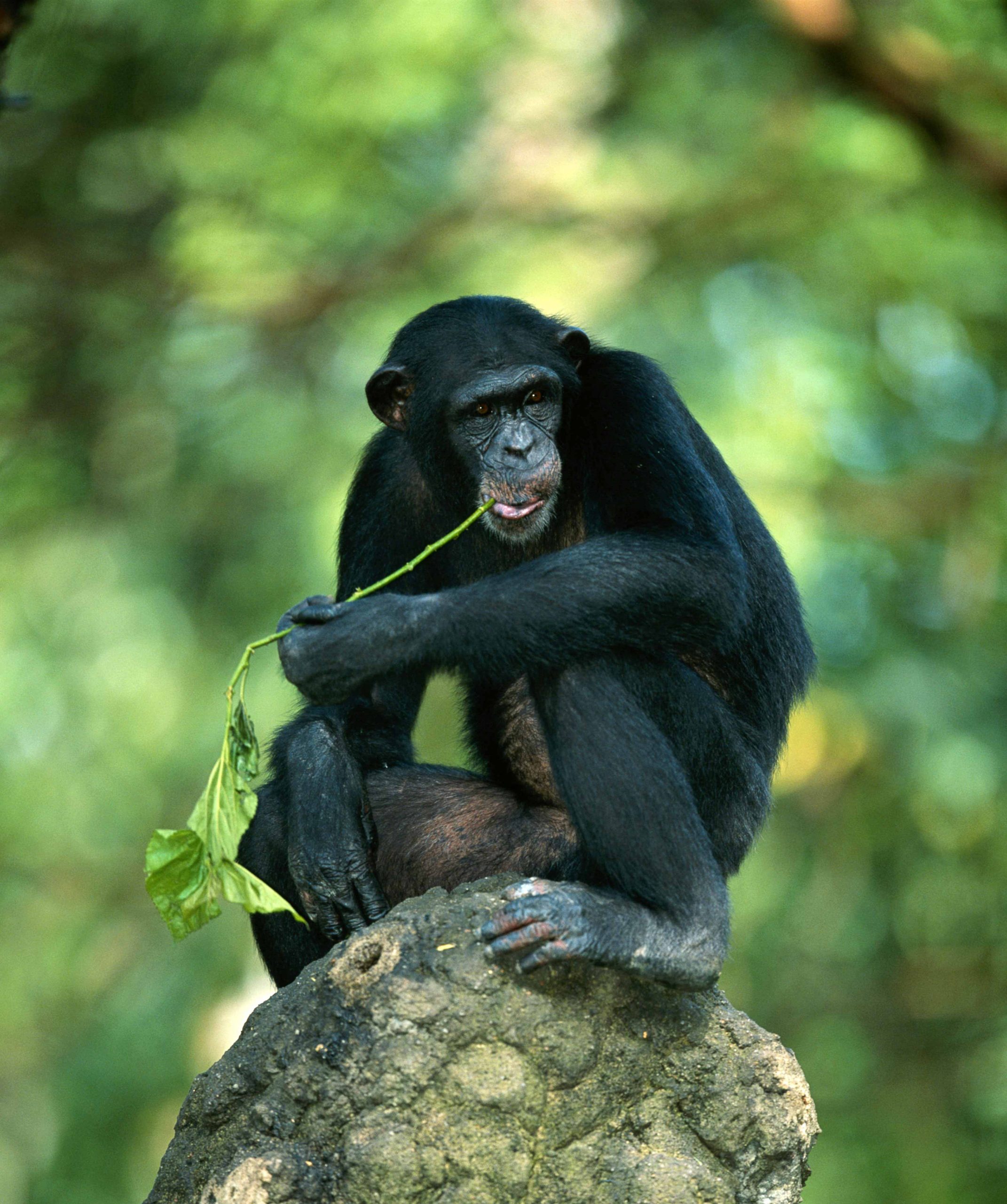Chimpanzee
Explore the chimpanzee, commonly known as simply “Chimp”: their social structures, behaviors, habitats, distribution, conservation status, and significance in Africa’s biodiversity.

Overview
The chimpanzee (Pan troglodytes), often simply referred to as the “chimp,” is a species of great ape native to the forests and savannas of tropical Africa. These remarkable primates exhibit a broad spectrum of behaviors that reflect their advanced cognitive abilities, making them a focal point of academic and scientific research. Chimpanzees are known for their complex social structures, intricate communication methods, and innovative tool use.
Scientific Classification
- Kingdom: Animalia
- Phylum: Chordata
- Class: Mammalia
- Order: Primates
- Family: Hominidae
- Genus: Pan
- Species: Pan troglodytes
Description
Chimpanzees are medium to large-sized primates, with males typically weighing between 40 to 60 kilograms (88 to 132 pounds) and females weighing slightly less, around 32 to 47 kilograms (70 to 104 pounds). They have a robust build, characterized by long arms that extend well past their knees, enabling them to move efficiently through the trees and on the ground. Their bodies are covered in coarse black hair, which provides insulation and protection against the elements. Unlike many other primates, their faces, ears, palms, and soles are bare and often lighter in color, with the skin ranging from pink to dark brown.
The facial features of chimpanzees are highly expressive, with prominent brow ridges, large forward-facing eyes, and a pronounced nose and mouth. These features facilitate complex facial expressions and vocalizations that are essential for communication within their social groups. Chimpanzees have large, sharp canine teeth, especially pronounced in males, which are used for defense and establishing dominance within the troop.
Chimpanzees exhibit sexual dimorphism, with males generally larger and more robust than females. This difference in size and strength plays a role in their social dynamics and reproductive strategies. Chimpanzees possess opposable thumbs and big toes, allowing them to grasp objects and use tools with remarkable dexterity. This combination of physical traits makes them exceptionally well-adapted to their arboreal and terrestrial lifestyles, capable of brachiation (swinging from tree limb to tree limb) as well as efficient movement on the ground, known as knuckle-walking.
Chimpanzees typically live around 33 years in the wild, though they can live over 50 years in captivity, where they are protected from predators and receive regular medical care.

Behaviour
Chimpanzees are known for their complex social structures and behaviors, which have been the subject of extensive research. They live in multi-male, multi-female communities, known as troops, that can range from 20 to over 100 individuals. These troops are characterized by a fluid social organization, with individuals forming temporary subgroups that change frequently. Social bonds within the troop are maintained through grooming, which is not only a hygienic activity but also a crucial social behavior that reinforces alliances and hierarchies.
Chimpanzees are highly intelligent and capable of using tools, a trait that was once thought to be uniquely human. They have been observed using sticks to extract termites from mounds, stones to crack open nuts, and leaves to soak up drinking water. This tool use is learned and passed down through generations, demonstrating a form of cultural transmission.
Communication among chimpanzees is multifaceted, involving vocalizations, facial expressions, and body postures. They use a variety of calls to convey information about food sources, predators, and social status. Their vocal repertoire includes hoots, grunts, and screams, each serving different communicative purposes. For instance, a series of pant-hoots may be used to gather the troop or signal excitement, while softer grunts can indicate contentment or greeting. Their facial expressions are incredibly expressive, capable of conveying a wide range of emotions, from aggression to playfulness.
Chimpanzees also engage in complex social behaviors, including coalition building and conflict resolution. Males often form alliances to increase their chances of becoming dominant within the troop, while females typically form strong bonds with other females and their offspring. These social dynamics are crucial for the survival and reproductive success of individuals within the troop.
Habitat
Chimpanzees inhabit a variety of environments across central and western Africa, including tropical rainforests, woodlands, and savannas. Their range extends from southern Senegal across the forested belt of central Africa to western Uganda and western Tanzania. This wide distribution reflects their adaptability to different habitats, though they generally prefer areas with dense vegetation that provide ample food resources and cover.
Chimpanzees establish home ranges that they use for foraging, nesting, and social interactions. These ranges can vary in size depending on the availability of resources and the density of the chimpanzee population. Within these home ranges, chimpanzees create and use a network of trails and sleeping nests, which are constructed in trees or on the ground depending on the environment and safety considerations.
Key countries where chimpanzees are found include:
- Gabon: The Loango National Park, with its diverse habitats ranging from dense rainforests to coastal lagoons. Loango National Park is a biodiversity hotspot, where chimpanzees share their habitat with elephants, gorillas, and a myriad of bird species. The park’s varied landscapes provide rich foraging grounds for chimpanzees, from forest fruits to marine resources.
- Uganda: Kibale National Park, known for its high density of primates, including chimpanzees.Kibale National Park offers one of the most accessible and reliable locations for observing chimpanzees in the wild. The park’s lush forests support a dense population of chimpanzees, making it a prime destination for researchers and tourists alike.
- Tanzania: Gombe Stream National Park, made famous by Jane Goodall’s groundbreaking research. Gombe Stream National Park, with its steep valleys and clear streams, provides a unique setting for chimpanzee study. Jane Goodall’s work here has revealed much about the social behaviors and family structures of these fascinating primates.
- Democratic Republic of Congo: The vast rainforests of the Congo Basin, home to large populations of chimpanzees.The Congo Basin’s rainforests are among the most biodiverse areas on the planet. Chimpanzees here thrive in the dense, remote forests, which offer a relative refuge from human activities.
- Ivory Coast: Taï National Park, one of the last major remnants of the primary rainforest in West Africa.Taï National Park is crucial for the conservation of West African chimpanzees. The park’s intact primary forest provides a vital habitat for these endangered primates, supporting a range of flora and fauna.
Conservation
Chimpanzees are classified as Endangered on the IUCN Red List of Threatened Species. The primary threats to their survival include habitat loss due to deforestation, hunting for bushmeat, and diseases such as Ebola. Human encroachment into their habitats has led to increased conflict and competition for resources, further exacerbating their decline.
Conservation efforts are focused on protecting and restoring habitats, enforcing anti-poaching laws, and promoting sustainable land-use practices. Additionally, education and awareness campaigns aim to reduce the demand for bushmeat and mitigate the spread of diseases. Research and conservation programs, such as those led by the Jane Goodall Institute, play a critical role in monitoring chimpanzee populations and developing strategies to ensure their long-term survival.
Facts
Interesting facts about The Chimpanzee (Pan troglodytes).
The scientific name of the chimpanzee is Pan troglodytes.
In the wild, chimpanzees typically live around 33 years, while in captivity they can live over 50 years.
Chimpanzees are omnivores, eating a varied diet that includes fruits, leaves, seeds, insects, and occasionally small mammals.
Chimpanzees inhabit the tropical rainforests, woodlands, and savannas of central and western Africa.
Chimpanzees use tools, engage in complex social interactions, and exhibit cultural behaviors passed down through generations.
They communicate using vocalizations, facial expressions, and body language to convey information and emotions.
Chimpanzee troops have a multi-male, multi-female structure with fluid subgrouping and strong social bonds maintained through grooming.
Chimpanzees use sticks, stones, and leaves as tools for foraging, cracking nuts, and absorbing water, demonstrating advanced problem-solving skills.
Jane Goodall is a renowned primatologist who conducted pioneering research on chimpanzees in Gombe Stream National Park, revealing their complex social behaviors and tool use.
Chimpanzees establish home ranges that vary in size depending on resource availability and population density, often covering several kilometers.
Other Animals
Explore fauna in Africa.






